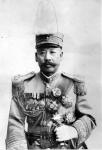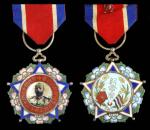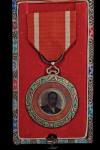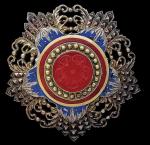-
Posts
851 -
Joined
-
Last visited
-
Days Won
3
Content Type
Profiles
Forums
Blogs
Gallery
Events
Store
Everything posted by drclaw
-
A very insightful analysis KimKan. I would fully agree. This one is the clincher. Pick a major auction house catalogue and you're likely to see multiple examples of Imperial Russian and Soviet orders compared to Chinese ones (at least Qing and Early Republic awards). This does not of course mean that one is more or less desirable than the other. Only that different market dynamics apply.
-
Non-payment that Paul mentions is a real problem, not just in ODM sales, and must be a nightmare for auction house staff. Chinese Poly Auctions requires new bidders not recommended by an existing client to lodge a HK$500,000 (approx USD 64,000) deposit for non-premium lots and HK$1,000,000 (USD $128,000) for premium lots! Perhaps the most famous instance of non-payment concerned the controversial sale by Christies of bronze fountainheads looted from the Old Summer Palace during the Second Opium Wars. There were 12 such heads, believed cast from designs made by Guiseppe Castiglione, and were part of a fountain in the largest of the palaces, the Haiyantang or Palace of Calm Seas. Over the years, several have surfaced and recovering them have become a cause celebre in China. In 2009, Christies in Paris auctioned two heads - the rat and rabbit - from the collection of Yves Saint Laurent amidst demands by the Chinese government for their return. The successor bidder, a well-known businessman Cao Minghcao, then refused to pay the 28 million euro successful bid saying the bids were for "moral and patriotic grounds". http://books.google.com.au/books?id=ymn7lketwMcC&pg=PT36&lpg=PT36&dq=sotheby+lost+treasures+auction+china&source=bl&ots=bWoKvZr0vH&sig=cTO1PLSTrzOyHRP2HUvWq0_--NU&hl=en&sa=X&ei=v4zRU-PwE8W2uATjkoBo&ved=0CCgQ6AEwAg#v=onepage&q=sotheby%20lost%20treasures%20auction%20china&f=false
-
Thanks KimKan and Nick for the information. The Memorandum for Amending the Double Dragon, dated 1897, proposed the adoption of breast stars so the First Type transitional breast stars likely dated after this time. Interestingly, many of the details contained in the 1897 regulations can be seen in the post 1902 Second Type Double Dragons. At the same time, there are a number of major differences too, e.g. the 1897 regulations specify that the star corpus of the Third Class should have green enamelled rays. We've seen these in transitional Third Class stars.
-
With the exception of the Godet specimens attributed to Prince Chun's visit in 1901, most if not all of the First Type breast stars appear to be Russian made with at least two makers identified so far: Feodor Ruckert and Bogdanov. According to Wiki, Feodor Ruckert "Worked with Carl Fabergé from 1887. His mark Ф.Р. (F.R. in Russian Cyrillic) can be found on cloisonné enamel objects made in Moscow, sold independently or by Fabergé." Nick - would you have any more information about Mikhail Bogdanov, other than that he won an Oscar for Best Foreign Film (War and Peace)?
-
Beautiful Nick! Thanks for posting this. Any thoughts about the breast star above the DD? A Bokhara award perhaps?
-
Possibly not. A French and a British officer of the foreign intervention force who both received 3rd Classes received the old First Type neck badges. So it's likely the Boxer Rebellion awards were the old First Type badges, or perhaps the transitional First Type breast stars. This neck badge appears to be the mid-period Second Type badge, which is the most frequently encountered style. Great images by the way Nick. Thanks for posting them.
-
Thanks Pieter for sharing these photos and information. That's what I love about this forum - it brings together the research and knowledge of so many experts, leading to stunning discoveries. Thanks to this forum, we've discovered among many other things: * the only example of the First Type First Class First Grade badge known - it's in Johor * that the First Type transitional breast stars were awarded as a set with the First Type badge, at least certainly for the First Class * that the First Type First Class oblong badges were also awarded as transitional breast stars When you're back from Japan and settled back home, I'd love to grab the high resolution photos for my file if you're happy to share them.
-
Oh wow!!!! I stand corrected about the First Type First Class transitional breast stars! So these were awarded as BOTH a badge and a breast star! But 1909? This would certainly be most unusual as this is well within the period of the Second Type Double Dragons. Is it possible to obtain any documentation on this? I'm guessing there's a dating error somewhere and this would be a pre-1902 award.
-
There is just one First Type First Class First Grade I'm aware of, and that's the award to the Sultan Abu Bakr of Johor and is held in the Royal Abu Bakar Museum. From the photo, it appears to be solid gold with no enamelling and is mounted with a large pearl. I'm hoping to see it in person later this year to confirm. See post #5. http://gmic.co.uk/index.php/topic/22785-royal-abu-bakar-museum-johor/ For the Second Type, you're quite correct that no one has seen a First Class First Grade. It's not known if one was even awarded. The design drawings suggest it's quite different to the others (a single dragon facing forward with a large pearl). I'm hoping for the day a specimen appears in a forgotten museum or in an auction somewhere. On the Morton & Eden Feodor Ruckert breast star, it's interesting to speculate if it would have sold at the price had it also been stamped Faberge. I reckon it would have. We might think ours a prohibitively expensive collecting field (especially with recent prices), but ODM is still has a way to go before it can compare to big money collecting fields like Old Masters paintings, Lalique jewellery, vintage classic automobiles or Ming / Qing Dynasty vases. But as KimKan says, it's all a matter of preference.
-
It's certainly a possibility KimKan given that: * First Type Third Class badges were awarded to foreign recipients in Beijing during 1901-02 in the aftermath of the Boxer Rebellion * First Type transitional breast stars, commissioned from Godet, were awarded by Prince Chun when he visited Berlin in 1901. The Second Class Double Dragon awarded to Generalmajor Paul v. Hoepfner, who was Inspekteur of Marine-Infanterie between 1896 and 1902, was also a First Class transitional breast star. http://gmic.co.uk/index.php/topic/59120-double-dragon-for-german-admiral/ Rick Research wrote: "As Generalmajor, von Höpfner commanded 3. Ostasiatische Infanterie Brigade (5. nd 6. OA Inf Regimenter), for which he received the Red Eagle Order 2nd Class with Oakleaves and Swords (RAO2EX), Bavarian Military Merit Order-Commander with Swords (BMV2X), and OldenburgHouse Order-Commander with Star and Swords (OV2aX, replacing previous no swords Commander 2nd Class which he is wearing here). Since he is not wearing either the Bavarian or upgraded Oldenburg Orders in this photo, that should help narrow down date of the portrait. (The China Medal was issued in 1902.) By 1902 he was back in Germany as the Commandant of Berlin under Military Governor Generaloberst von Hahnke. He received the Double Dragon some time between 1897 and 1901. I don't have access to the naval rank lists 1897-1900 at the moment, but wonder if he actually received that award in Germany before the Boxer rebellion, for something to do with a visiting Imperial military delegation?" The star corpus of Von Hoepfner's breast star is however different to the Godet example awarded by Prince Chun in 1901 which had diamond cut rays. There are three possibilities for von Hoepfner's star: (1) he received it from Li Hongzhang in 1896 - Li was in Berlin in June 1896 where he met Bismarck (2) he received it in Beijing in 1901 where he was part of the foreign expeditionary force (3) he received it from Prince Chun in 1901 in Berlin after von Hoepfner returned from China - Prince Chun met with Kaiser Wilhelm II on 27 August 1901 Note that the star corpus of von Hoepfner's breast star has sharp, narrow rays while the Godet insignia were diamond cut rays. It's possible that Prince Chun commissioned insignia from different Berlin jewellers with different styled star corpuses but that's unlikely. Interestingly, the von Hoepfner star corpus is very similar to the Bogdanov specimen in the July 2014 Spink auction and the Feodor Ruckert specimen in the December 2011 Morton & Eden auction. They are also similar to what might be described as the early Second Type Double Dragon breast stars, like this one in the Morton & Eden December 2012 auction. So we can see an evolution in the Double Dragon insignia: (1) First Type Badges 1882 - 1902, with a number awarded to members of the Boxer Rebellion expeditionary force in 1901-02 (2) Transitional insignia (a) First Type transitional breast stars - 1894/96?-1902. These have a reduced size Chinese made First Type badge mounted on a European made star corpus. Only the Second and Third Class have been encountered. Presumably the tablet shaped First Class badges were not amenable in design to being mounted on a star. (b) Second Type transitional breast stars - 1896?-1902. These appear similar to the Second Type breast stars except they are very flat and made from a single sheet of metal. (3) Second Type Double Dragons (a) early Second Type breast stars - 1902? The points of the star corpus are composed of five groups of three rays and is similar in design to the transitional breast stars 2(a) and (b). (b) mid Second Type breast stars - these are the most frequently encountered; the points of the star are composed of three groups of three rays. Given their frequency, we can conclude that these were awarded over the longest period during the life of the Second Type 1902-1912 © late Second Type breast stars - similar to (4) but "reduced size" at around 82 mm in diameter as opposed to around 92 mm in diameter for the (3) and (4). KimKan has done extensive research on recipients that place these reduced size specimens as late awards. It appears that around 1902, a variety of different style insignia were still being awarded. Certainly, it was a transitional period for China in the aftermath of the Boxer Rebellion and the return of the Imperial Court from Xian where it had fled as the Eight Nation Alliance force marched on Beijing.
-
We should be taking bets! But of course you never know who's bidding on the day. The Double Dragons in the April Spink auction went for less than what I'd have imagined but this was shortly after the Hong Kong auction. The 2008 UBS Tammann catalogue has two First Type Third Class transitional breast stars where the badges were of similar manufacture while the star corpus were very different and European made (by Godet and a Russian St Petersburg maker). The catalogue posits, correctly in my view, that the badges were made in China and the star corpus by European jewellers. Interestingly, First Type badges - continued to be awarded right up to 1902 together with the First Type transitional breast stars. KimKan and I have identified at least two examples of First Type Third Class badges awarded to a British and a French officer who participated in the Boxer Rebellion expeditionary force. The awards would have been made in 1901-02. When Puyi's father Prince Chun visited Berlin to express regrets for the assassination of German Minister Baron von Ketteler, he commissioned First Type transitional breast stars from Godet.
-
I think you're right KimKan. That's how consumer tastes evolve with economic development. First you want a flatscreen TV, then a car, then an overseas holiday, then designer clothes and jewellery, finally fine wine and art. China passed the designer clothes and jewellery stage in the early 2000s so now it's fine wine, collectibles and art. After decades of neglect, there's also a resurgence of interest in history - not just the Imperial past, but also the Republican and Nationalist period.
-
Ah, my mistake. I scrolled down from the characters to the 1st Cohort and missed the Praetorians. They look brilliant! Could you post some larger photos of maybe a couple of individuals? I've always liked their helmets. Did the Warlord Games sets come with the Praetorian shield transfers?
-
Thanks for posting these Larry. I've been eyeing a "Gladiator" style Roman army too and love your Marcus Aurelius and Maximus plus dog models. Crusader Miniatures have a Joaquim Phoenix in white armour too should you ever decide to go the full hog. Are you painting up any Praetorian Guard in blue cloaks? http://www.crusaderminiatures.com/prod.php?prod=609&cat=1&sub=27&page=2
-
Here's a photograph of Cao Kun who was President in 1923-24. On the top left breast are three inauguration medals bearing the portraits of three of the first four Presidents of the Republic. From right to left: Xu Shichang, Feng Guozang and Yuan Shikai. But where's Li Yuanhong - who was President between Yuan Shikai and Feng Guozhang, and again 1922-23 after Xu Shichang? During Li's second Presidency, Cao Kun and his lieutenant Wu Beifu forced Li from office. He obviously had little respect for Li. Hence Li's portrait medal is missing from the row of Presidential Inauguration Medals on Cao Kun's chest!
-
Thanks for this great information KimKan. I wasn't aware of King's article so will track down a copy through OMSA. King's articles are always meticulously researched so if he's written a paper on this, that will be the definitive work. The Chinese language reference catalogue I have lists some three dozen medals that they describe as: 纪念章 (ji nian zhang) These include the Presidential Inauguration Medals that we've seen, as well as other commemoration medals including those bearing the image of a President. 纪 = historical 念 = commemoration 章= medal This inscription is also found on the case of the Yuan Shikai Inauguration Medal.
-
Cao Kun Inauguration Medal From the Morton and Eden and OMSA archives. Cao Kun infamously bribed Assembly members 5000 silver dollars each to elect him President. The silver dollars may or may not have included a portrait of himself ... The date on the medal is the 12th year 10th month 10th day, i.e. 10 October 1923. Of course, 10 October 1911 is the date of the Wuchang Uprising that started the 1911 Revolution that overthrew the Qing Dynasty.
-
Xu Shichang Inauguration Medal "Xu Shichang Inauguration, October 1918, commemorative medal, in silver-gilt and enamels, with central photographic-style portrait of Xu Shichang, width 40mm, with original riband, good very fine." Comment: The seal script inscription on the medal has the date "Mingguo qi nian shi yue shi re" or Republic 7th Year 10th Month 10th Day (i.e. 10 October, 1918). http://gmic.co.uk/uploads/monthly_06_2014/post-11630-0-62717900-1403647302.jpghttp://gmic.co.uk/uploads/monthly_06_2014/post-11630-0-17516600-1403647320.jpghttp://gmic.co.uk/uploads/monthly_06_2014/post-11630-0-60143700-1403647336.jpg
-
We've seen these appear on a fairly regular basis. Unfortunately, I've not been able to find much by way of information on these medals. Many references refer to these medals as "Presidential Inauguration Medals". The dates on the medals however refer to an anniversary of the 10 October 1911 Wuchang Uprising that launched the 1911 Revolution. The date on Yuan Shikai's medal is 10 October 1913, Xu Shichang's is 10 October 1918 and Cao Kun's is 10 October 1923. So I'm wondering whether these were more a commemoration of anniversary of the Wuchang Uprising Medal than a Presidential Inauguration Medal per se. Other questions: How many were issued? To whom were they awarded to? Here's a list of the Presidents of the Early Republic: * Yuan Shikai (1912-16) * Li Yuanhong (1916-17) * Feng Guozhang (1917-18) * Xu Shichang (1918-22) * Zhuo Ziqi (1922) * Li Yuanhong (second Presidency) (1922-23) * Gao Lingwei (1923) * Cao Kun (1923-24) * Huang Fu (1924) * Duan Qirui (1924-26) * Hu Weide (1926) * Yan Huiqing (1926) * Du Xigui (1926) * Gu Weijun (1926-27) * Zhang Zuolin (1927-28) That's why it's called the Warlord Era! With the exceptions of Yuan Shikai and Xu Shichang, most of the others barely lasted 18 months. Let's see how many Inauguration Medals we can identify. I'll start the ball rolling with two excellent offerings from Morton and Eden's upcoming 2 July Orders, Decorations and Medals auction. Yuan Shikai Inauguration Medal "Yuan Shikai Inauguration, October 1913, commemorative medal, in silver-gilt and enamels, with central photographic-style portrait of Yuan Shikai, width 40mm, in case of issue with original riband, good very fine." Comment: The characters on the medal are in traditional seal script. The date is "Mingguo er nian shi yue shi re" or Republic 2nd Year 10th Month 10th Day (i.e. 10 October, 1913). The 1st Year of the Republic is 1912. Yuan Shikai was sworn in as Provisional President of the Republic on 10 March 1912. That might be consistent with why the medal is dated the year later 1913. http://gmic.co.uk/uploads/monthly_06_2014/post-11630-0-72719500-1403646859.jpghttp://gmic.co.uk/uploads/monthly_06_2014/post-11630-0-65811800-1403646873.jpg
-
Here are some stunning images from the example in Morton and Eden's upcoming 2 July auction. It's stamped number 143 and comes in its original black lacquer presentation case with the characters Da Shou Cai Yu Xun Zhang (Grand Cordon Brilliant Jade Order). http://gmic.co.uk/uploads/monthly_06_2014/post-11630-0-35038100-1403645367.jpghttp://gmic.co.uk/uploads/monthly_06_2014/post-11630-0-96915100-1403645384.jpg http://gmic.co.uk/uploads/monthly_06_2014/post-11630-0-91147300-1403645408.jpghttp://gmic.co.uk/uploads/monthly_06_2014/post-11630-0-10196800-1403645424.jpg
-

Persia - Order of the Lion and the Sun
drclaw replied to drclaw's topic in Middle East & Arab States
Congratulations Michel, once you own your first European made Lion, you'll probably won't stop. Just ask Markus! -
The Fourth Class Double Dragon in the Willi Blessing group should have an opaque blue centre stone. The orange stone is therefore a likely replacement. Nice Double Dragon Hugh!
-
Thanks posting this KimKan. Yes, that is a beauty, especially given it is in its original lacquer case. If the Third Class Grand Cordon set was the highest possible grade bestowed upon foreigners, that would explain why most of the examples of the Brilliant Jade we've seen are the Third Class. The other classes were only rarely awarded. It might also explain why there's so few 1st and 2nd Class awards encountered. If these were ONLY awarded to Chinese, then for the insignia to have survived: (1) the recipient must have fled to Taiwan with the Nationalists; and (2) the recipient must have brought the insignia with them. As we've seen, many high ranking Nationalists chose to stay on the mainland with the Communists. They would likely have destroyed their insignia, especially during the Cultural Revolution.
















